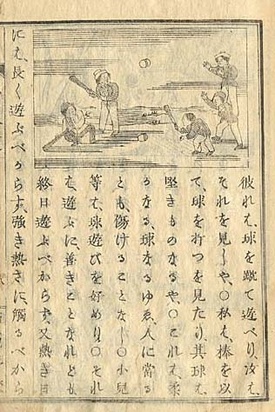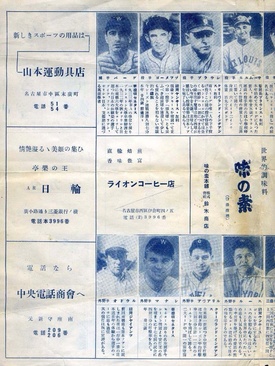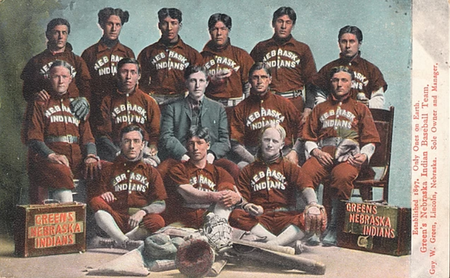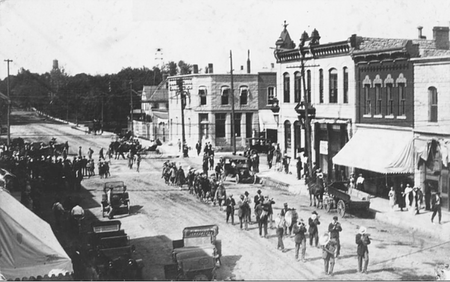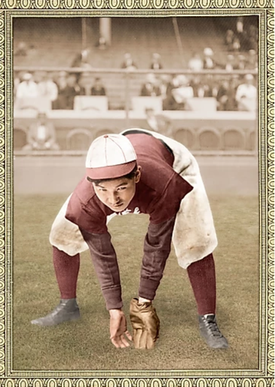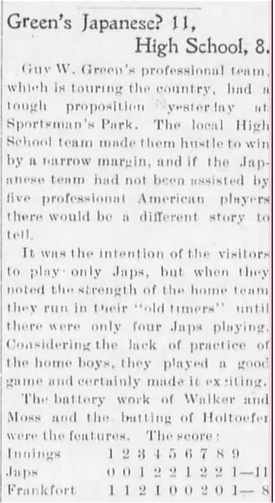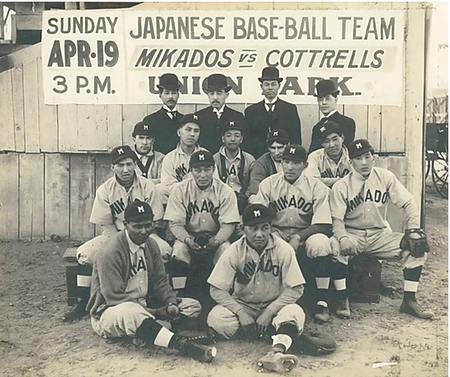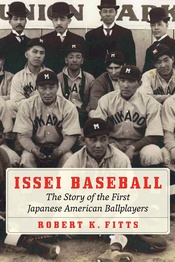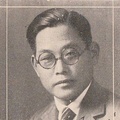Who’s on first in Japanese baseball
American baseball historians have a fetish for documenting first occurrences: the first game, the first curveball, the first no-hitter, the first player of each ethnicity. It’s no different in Japan.
Baseball in Japan has a long, well documented history. The first game on Japanese soil was played in late-October 1871 in Yokohama between American residents and members of the visiting crew from the USS Colorado. A year later, American teacher Horace Wilson introduced the game to his Japanese students at Daiichi Daigaku (later Kaisei Gakkko) in Tokyo. In 1878, Hiroshi Hiraoka, returning from six years studying in the United States, founded the Shinbashi Athletic Club—the first all Japanese baseball team. The game flourished in Japan’s elite private schools in Tokyo before spreading across the country in 1896 following the upset victory of the Japanese First Higher School (a high school) over the adult American team from the Yokohama Country and Athletic Club.
During the first few decades of the 20th century, baseball would become Japan’s most popular sport—played at nearly every middle school, high school, and college in the country. But it remained an amateur endeavor. Influenced by the mythical Bushido Code, Japanese athletes were expected to play for the love of the sport and not monetary gain. Most Japanese considered professional sports immoral. As a result, professional clubs were not created in Japan until the 1920s when several independent teams were formed. Still facing moral opposition, these teams folded after just a few seasons. In the wake of Babe Ruth and his All-American team’s visit in 1934, objections to professional baseball disintegrated and the present Nippon Professional Baseball league began play in 1936.
In the mid-1990s, baseball historian Kazuo Sayama discovered that the first Japanese professional played in the United States not Japan. In his book “Jappu Mikado” no nazo: Bei pro yakyu Nihonjin daiichigo o ou (The Mystery of “Jap Mikado” First Japanese in American Professional Baseball, Tankobon, 1996), Sayama identifies Goro Mikami, a graduate of Waseda University who played for the independent barnstorming All Nations team in 1914 and 1915, as Japan’s first professional player.
But with the proliferation of searchable digital newspaper archives, we now know that before Mikami, an independent professional team called Green’s Japanese Base Ball Team barnstormed across the Midwest in the summer of 1906. They played their first game in a tiny town in Northeastern Kansas, 114 years ago this week.
In 1906, much of United States was enthralled by Japan and all things Japanese. Japan had just emerged as the improbable victor in the Russo-Japanese War and the year before the Waseda University baseball club had toured the West Coast. Guy W. Green, the owner of the Nebraska Indians Baseball Club, decided to capitalize on the fad by creating an all-Japanese baseball team to barnstorm across the Midwest. It would be the first Japanese professional team on either side of the Pacific.
The early twentieth century was the heyday of barnstorming baseball. Independent teams crisscrossed the country playing in one-horse towns and large cities. There were all female teams, squads of only fat men, clubs of men sporting beards, and teams consisting of “exotic” ethnicities. These independent squads were often called “semi-professional” to differentiate them from teams in Organized Baseball (clubs formally associated with Major League Baseball), but they were professional enterprises. The teams signed players to contracts, paid salaries during the season, provided transportation and housing on the road, charged admission to games, and were intent on turning a profit.
Although Green would claim that he had “scour[ed] the [Japanese] empire for the best players obtainable,” he did nothing of the sort. In early 1906, Green instructed Dan Tobey, captain of the Nebraska Indians, to form a team from Japanese immigrants living in California. Tobey focused his efforts on Los Angeles, recruiting members of an amateur team associated with the Rafu Shimpo newspaper. All of these men had played high school baseball in Japan. Players congregated on March 15 in Havelock, Nebraska for two weeks of practice. It soon became evident that not all of his recruits were strong enough to play on a professional independent squad, so Green and Tobey decided to bolster his roster with Native Americans—hoping that most spectators would not be able to tell the difference.
The starting lineup featured five Japanese: Toyo Fujita, a writer for The Rafu Shimpo, at first base; Tetsusaburo Uyeda from Yamaguchi Prefecture at second; 21-year-old Ken Kitsuse from Kagoshima at short; 21-year-old Umekichi “Kitty” Kawashima from Kanagawa; and a man identified only as Naito in the outfield. Manager Dan Tobey and Nebraska Indian veteran Sandy Kissell shared the pitching duties and played outfield on their off days. Seguin, another member of the Nebraska Indians, was the catcher. Roy Dean Whitcomb, an 18-year-old Caucasian from Lincoln, usually played third base under the name Noisy, while a man known only as Doctor filled in as necessary.
On the evening of April 13, Green’s Japanese Base Ball Team left Havelock and headed south to begin a 25-week tour that would cover over twenty-five hundred miles through Nebraska, Kansas, Oklahoma, Texas, Arkansas, Indiana, Illinois, Iowa, and Missouri. Their first stop was Frankfort, a small town of about 1,400 people in northeastern Kansas, where they would play the town’s high school squad.
Prior to the game, Guy Green sent out promotional material and flooded local newspapers with advertising and press releases. At the time, there were so few Japanese living in the Midwest that many rural farmers had never seen a Japanese person. So, Green’s advertisements emphasized the players’ foreignness and the uniqueness of the team. A typical announcement read, “Green’s [team] are the most novel baseball organization the world has ever known. Every player is a genuine Japanese. Not one of them can speak a word of English. They do all their coaching in Japanese and is certainly the most Japanesy Japanese you have ever listened to.”
Playing on the public’s fascination with the Russo-Japanese War, Green also concocted fictional backgrounds for his players. An April 13, 1906 article in the Frankfort Review noted, “One of the most interesting members of Green’s Japanese baseball team is Kitsuse, who left school in Japan to serve during the last great war with Japan. He was wounded in the left leg at Mukden so severely that he was compelled to go home and even yet he limps slightly. He is one of the best men on the team, however, and always a great favorite with the crowds.” Kitsuse, however, immigrated to California on June 8, 1903, almost two years before the 1905 Battle of Mukden.
On Sunday, April 15, the two teams met on a leveled field just outside of town. There were no grandstands or bleachers—spectators sat and stood on a raised berm that surrounded the diamond. The high schoolers took the field in brand-new red and grey uniforms that had just arrived a couple of days before. The Japanese squad wore white pants reaching just below the knees, wide leather belts, maroon stockings, maroon undershirts, and winged-collared maroon jerseys with “Greens Japs” stitched in white block letters across the chest. The caps were white with maroon bills.
As the high school contained just 41 students, the match should have been an easy victory for Green’s independent team. Perhaps seeing the game as an opportunity to allow his weaker players to gain experience, Tobey started a mostly Japanese lineup. But Tobey had underestimated the skinny, 15-year-old redhead on the mound. The teenage ace, Fairfield “Jack” Walker, would go on to pitch for the University of Kansas in 1911–12 and professionally in the Class D Nebraska State League and the Eastern Kansas League. Although he was a quiet kid, the Horton Headlight noted “when playing Walker wears a perpetual grin that makes a lot of batters mad because they think he is laughing at them.”
Besides Walker, the school’s lineup consisted of George Moss behind the plate; a boy identified only as Russell at first; Harold Haskins at second; Willis Cook at third; Leo Holthoefer at short; and Robert Barrett, John McNamara, and Carrol Walker in the outfield.
The schoolboys jumped out to an early 4–1 lead after three innings, forcing Tobey to bring in what the Marshall County Index called “five professional American players.” The visitors battled back, scoring in every inning after the second, to eventually win 11–8. The Frankfort Review reported, “A large number of people witnessed the game and they prounce [sic] it one of the best games ever played here.”
The near loss to schoolboys confirmed Tobey’s view that many of his Japanese players were not talented enough for an independent team. Green’s Japanese squad would stay on the road until October 10, playing about 170 games and winning 122 of the 142 games for which results are known, but there is no record of the team using an all Japanese starting lineup again.
Despite the lengthy tour and the uniqueness of the club, The Sporting News, as well as big market newspapers in New York, Washington, and Los Angeles, did not cover or even mention Green’s Japanese team. As a result, the first professional Japanese players had little impact on the national or international baseball scene and were soon forgotten. But the tour marked the true beginnings of Japanese American baseball. After the season, the players headed back to the West Coast to form independent Japanese ball clubs. The Mikado Base Ball Club of Denver would barnstorm in Colorado and Kansas in 1908, while the Nanka of Los Angeles would play at the amateur level before changing its name to the Japanese Base Ball Association and becoming an independent barnstorming team in 1911. These teams’ success helped spawn numerous Nikkei clubs as baseball became an integral part of the Japanese American community and culture.
* * * * *
You can read more about Guy Green’s Japanese Base Ball Team and the early pioneers of Japanese American baseball in my new book Issei baseball: The First Japanese American Ballplayers (University of Nebraska Press, 2020). It is available at robfitts.com, your local bookstore, or Amazon.
I would like to thank Alice Jones of the Frankfort City Library and Dwight “Skip” McMillen for their invaluable help searching the archives in Frankfort, Kansas.
* * * * *
Identified Frankfort Players:
Frank Robert Barrett (born April 16, 1888, Frankfort, KS—died December 28, 1968, Los Angeles)
James Willis Cook (born April 30, 1887, Frankfort, KS—died December 13, 1960, San Anselmo, CA)
Harold Haskins (born ca. 1892–12/6/1918, died in the 1918 influenza epidemic)
Leo Holthoefer (born January 1, 1886, Atchison, KS—died December 12, 1927, Denver, CO)
John McNamara (born 1890, Nebraska)
George Edward Moss (born October 6, 1887, Frankfort KS—died June 13, 1961, Frankfort, KS)
Fairfield “Jack” Walker (born February 20, 1891, Frankfort, KS—died 1951, Wichita, KS)
*This article was originally published on ourgame.mlblogs.com on April 13, 2020.
© 2020 Robert K. Fitts


